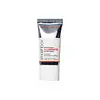What's inside
What's inside
 Key Ingredients
Key Ingredients

 Benefits
Benefits

 Concerns
Concerns

 Ingredients Side-by-side
Ingredients Side-by-side

Butyl Methoxydibenzoylmethane 3%
UV AbsorberEthylhexyl Salicylate 4%
UV AbsorberOctocrylene 8%
UV AbsorberAloe Barbadensis Leaf Juice
Skin ConditioningButyloctyl Salicylate
Skin ConditioningGlycerin
HumectantAmmonium Acryloyldimethyltaurate/Vp Copolymer
CI 77163
Cosmetic ColorantLactobacillus Ferment
Skin ConditioningJasminum Sambac Leaf Cell Extract
MaskingTheobroma Cacao Seed Extract
AntioxidantSchinus Molle Extract
Skin ProtectingWater
Skin ConditioningTitanium Dioxide
Cosmetic ColorantEthyl Ferulate
AntioxidantTropolone
Skin ConditioningMica
Cosmetic ColorantHydroxyacetophenone
AntioxidantPropanediol
SolventButylene Glycol
HumectantSodium Stearoyl Glutamate
Cleansing1,2-Hexanediol
Skin ConditioningCaprylyl Glycol
EmollientEthylhexyl Hydroxystearate
EmollientMaltodextrin
AbsorbentSodium Phytate
Parfum
MaskingButyl Methoxydibenzoylmethane 3%, Ethylhexyl Salicylate 4%, Octocrylene 8%, Aloe Barbadensis Leaf Juice, Butyloctyl Salicylate, Glycerin, Ammonium Acryloyldimethyltaurate/Vp Copolymer, CI 77163, Lactobacillus Ferment, Jasminum Sambac Leaf Cell Extract, Theobroma Cacao Seed Extract, Schinus Molle Extract, Water, Titanium Dioxide, Ethyl Ferulate, Tropolone, Mica, Hydroxyacetophenone, Propanediol, Butylene Glycol, Sodium Stearoyl Glutamate, 1,2-Hexanediol, Caprylyl Glycol, Ethylhexyl Hydroxystearate, Maltodextrin, Sodium Phytate, Parfum
Water
Skin ConditioningC12-20 Acid PEG-8 Ester
EmulsifyingCaprylic/Capric Triglyceride
MaskingCoco-Caprylate/Caprate
EmollientGlycerin
HumectantButylene Glycol
HumectantCetyl Ricinoleate
EmollientCetyl Alcohol
EmollientAscorbyl Glucoside
AntioxidantSaccharum Officinarum Extract
MoisturisingAlgae Extract
EmollientPassiflora Edulis Seed Oil
EmollientRosa Hybrid Flower Extract
Skin ConditioningLycium Chinense Fruit Extract
AntioxidantVaccinium Macrocarpon Fruit Extract
AstringentVaccinium Angustifolium Fruit Extract
Skin ProtectingTocopheryl Acetate
AntioxidantNiacinamide
SmoothingSqualane
EmollientSodium Hyaluronate
HumectantHydroxyethyl Urea
HumectantCaffeine
Skin ConditioningHordeum Vulgare Extract
EmollientTriticum Vulgare Germ Extract
Skin ConditioningLactobacillus Ferment
Skin ConditioningSodium Polyaspartate
HumectantTrehalose
HumectantSorbitol
HumectantHydrolyzed Yeast Protein
Skin ConditioningYeast Extract
Skin ConditioningIsopropyl Isostearate
EmollientPEG-100 Stearate
PPG-15 Stearyl Ether
EmollientCaprylyl Glycol
EmollientHydrogenated Polydecene
EmollientLaureth-8
EmulsifyingCarbomer
Emulsion StabilisingSodium Acrylate/Sodium Acryloyldimethyl Taurate Copolymer
Emulsion StabilisingSilica
AbrasiveSynthetic Fluorphlogopite
Xanthan Gum
EmulsifyingDimethicone
EmollientTriethoxycaprylylsilane
Pentylene Glycol
Skin ConditioningTin Oxide
AbrasiveSodium Hydroxide
BufferingCitric Acid
BufferingSodium Citrate
BufferingDisodium EDTA
BHT
AntioxidantPotassium Sorbate
PreservativeSodium Benzoate
MaskingPhenoxyethanol
PreservativeMica
Cosmetic ColorantCI 77891
Cosmetic ColorantCI 77491
Cosmetic ColorantWater, C12-20 Acid PEG-8 Ester, Caprylic/Capric Triglyceride, Coco-Caprylate/Caprate, Glycerin, Butylene Glycol, Cetyl Ricinoleate, Cetyl Alcohol, Ascorbyl Glucoside, Saccharum Officinarum Extract, Algae Extract, Passiflora Edulis Seed Oil, Rosa Hybrid Flower Extract, Lycium Chinense Fruit Extract, Vaccinium Macrocarpon Fruit Extract, Vaccinium Angustifolium Fruit Extract, Tocopheryl Acetate, Niacinamide, Squalane, Sodium Hyaluronate, Hydroxyethyl Urea, Caffeine, Hordeum Vulgare Extract, Triticum Vulgare Germ Extract, Lactobacillus Ferment, Sodium Polyaspartate, Trehalose, Sorbitol, Hydrolyzed Yeast Protein, Yeast Extract, Isopropyl Isostearate, PEG-100 Stearate, PPG-15 Stearyl Ether, Caprylyl Glycol, Hydrogenated Polydecene, Laureth-8, Carbomer, Sodium Acrylate/Sodium Acryloyldimethyl Taurate Copolymer, Silica, Synthetic Fluorphlogopite, Xanthan Gum, Dimethicone, Triethoxycaprylylsilane, Pentylene Glycol, Tin Oxide, Sodium Hydroxide, Citric Acid, Sodium Citrate, Disodium EDTA, BHT, Potassium Sorbate, Sodium Benzoate, Phenoxyethanol, Mica, CI 77891, CI 77491
Ingredients Explained
These ingredients are found in both products.
Ingredients higher up in an ingredient list are typically present in a larger amount.
Butylene Glycol (or BG) is used within cosmetic products for a few different reasons:
Overall, Butylene Glycol is a safe and well-rounded ingredient that works well with other ingredients.
Though this ingredient works well with most skin types, some people with sensitive skin may experience a reaction such as allergic rashes, closed comedones, or itchiness.
Learn more about Butylene GlycolCaprylyl Glycol is a humectant and emollient, meaning it attracts and preserves moisture.
It is a common ingredient in many products, especially those designed to hydrate skin. The primary benefits are retaining moisture, skin softening, and promoting a healthy skin barrier.
Though Caprylyl Glycol is an alcohol derived from fatty acids, it is not the kind that can dry out skin.
This ingredient is also used as a preservative to extend the life of products. It has slight antimicrobial properties.
Learn more about Caprylyl GlycolGlycerin is already naturally found in your skin. It helps moisturize and protect your skin.
A study from 2016 found glycerin to be more effective as a humectant than AHAs and hyaluronic acid.
As a humectant, it helps the skin stay hydrated by pulling moisture to your skin. The low molecular weight of glycerin allows it to pull moisture into the deeper layers of your skin.
Hydrated skin improves your skin barrier; Your skin barrier helps protect against irritants and bacteria.
Glycerin has also been found to have antimicrobial and antiviral properties. Due to these properties, glycerin is often used in wound and burn treatments.
In cosmetics, glycerin is usually derived from plants such as soybean or palm. However, it can also be sourced from animals, such as tallow or animal fat.
This ingredient is organic, colorless, odorless, and non-toxic.
Glycerin is the name for this ingredient in American English. British English uses Glycerol/Glycerine.
Learn more about GlycerinLactobacillus Ferment is created by fermenting the Lactobacillus bacteria. It helps keep our skin's natural barrier and microbiome healthy.
Studies show lactobacillus ferment to be effective at repairing the skin barrier. Having a healthy skin barrier helps keep your skin healthy and hydrated. It also protects against bad bacteria.
As a probiotic/prebiotic/postbiotic, Lactobacillus ferment can help regular our natural biome. In fact, one study found a lack of diversity in our natural skin biome can trigger acne.
Learn more about Lactobacillus FermentMica is a naturally occurring mineral used to add shimmer and color in cosmetics. It can also help improve the texture of a product or give it an opaque, white/silver color.
Serecite is the name for very fine but ragged grains of mica.
This ingredient is often coated with metal oxides like titanium dioxide. Trace amounts of heavy metals may be found in mica, but these metals are not harmful in our personal products.
Mica has been used since prehistoric times throughout the world. Ancient Egyptian, Indian, Greek, Roman, Aztec, and Chinese civilizations have used mica.
Learn more about MicaWater. It's the most common cosmetic ingredient of all. You'll usually see it at the top of ingredient lists, meaning that it makes up the largest part of the product.
So why is it so popular? Water most often acts as a solvent - this means that it helps dissolve other ingredients into the formulation.
You'll also recognize water as that liquid we all need to stay alive. If you see this, drink a glass of water. Stay hydrated!
Learn more about Water